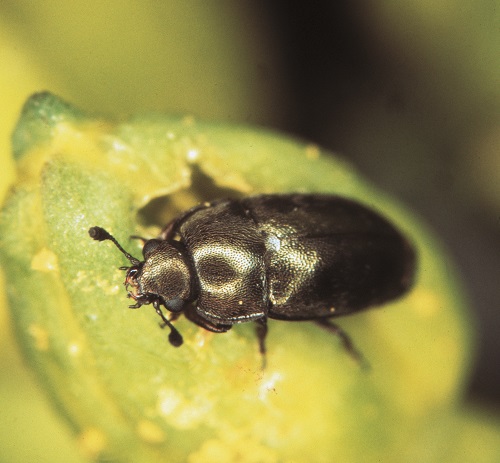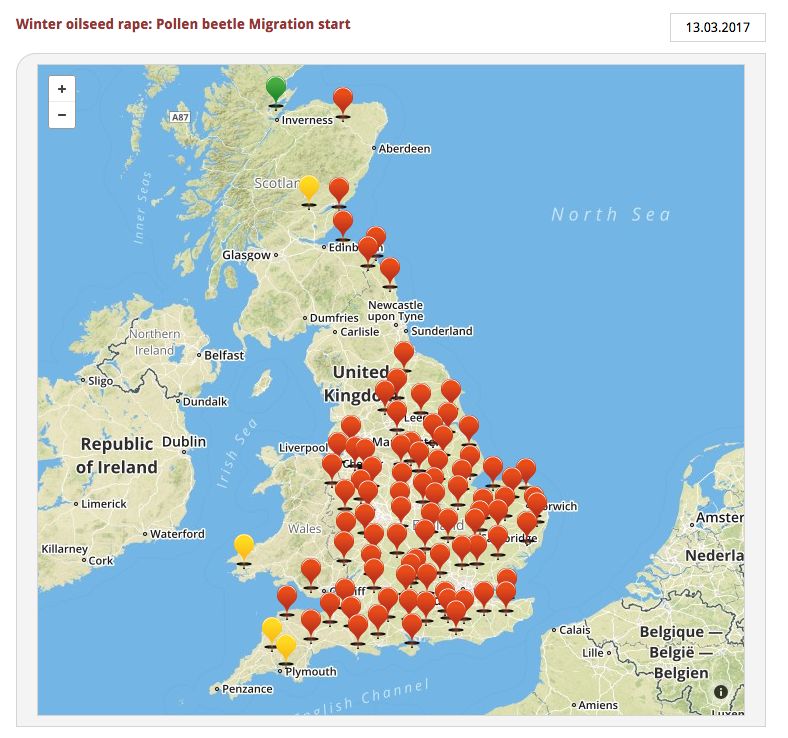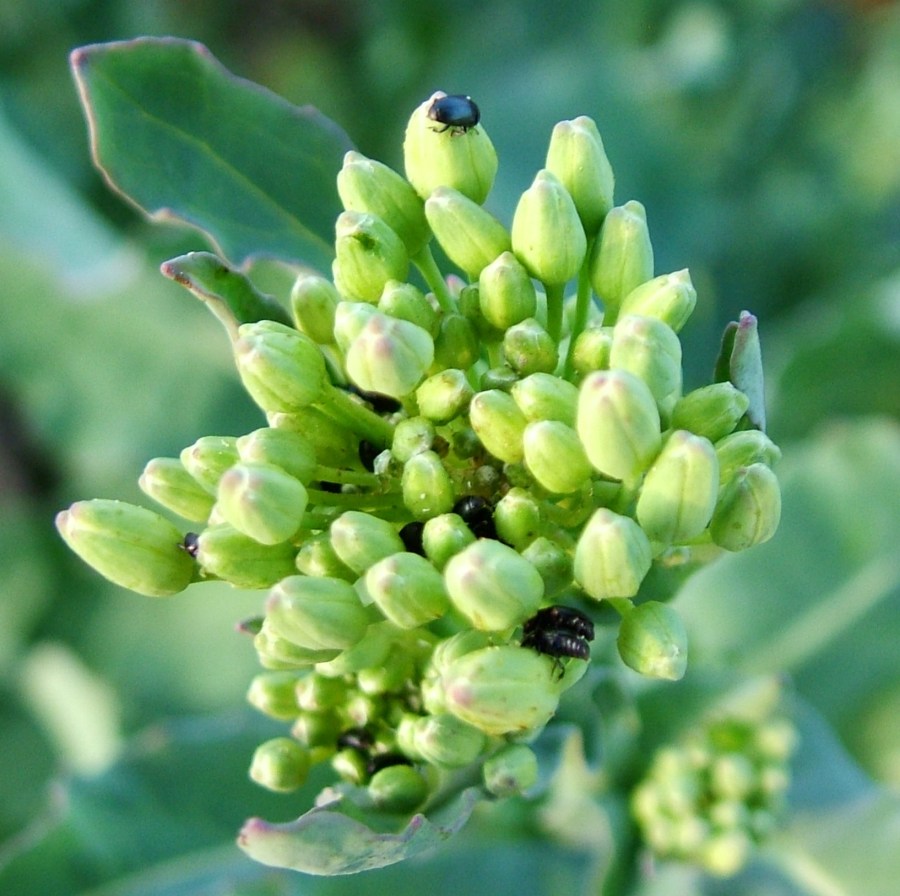As the first sightings of pollen beetle are confirmed in oilseed rape crops, leading industry experts are urging caution when deciding whether to treat. CPM finds out more.
By Lucy de la Pasture
Over the past two weeks, the first oilseed rape crop flowers have been popping up in the earliest of crops, with many at the green to yellow bud stage. According to reports, the annual pollen beetle migration is also underway, but how much risk is there? Are these shiny black beetles friend or foe?
Thinking on the pest has changed in recent years, explains agronomist Andrew Cromie, based in Cambs and a member of the Hutchinsons team. Many crops will easily compensate for lost flowers and with pyrethroid resistance now

Andrew Cromie says very few OSR crops will merit a treatment for pollen beetle.
widespread across the UK, insecticide treatment should only be used as a last resort, he believes.
“Just because you see pollen beetles in a crop, doesn’t mean it’s a bad thing. Pollen beetles rarely cause major problems and in many cases, it’s worth trying to avoid treating wherever possible.”
Pollen beetles migrate to winter OSR crops from mid-March and throughout April. If flowers aren’t open, the hungry beetles bite into the buds in order to obtain sustenance, which causes the flower to abort. Damage from the beetles declines as the flowers begin to open and pollen becomes more easily obtainable.
But it’s not just the adults that can cause problems. Pollen beetles lay their eggs in closed buds and when the larvae hatch, they feed within the buds and in flowers throughout May before dropping to the soil to pupate.
A new generation of adults emerges in June-July and feed on pollen from a wide range of flowers, including spring OSR. Adults then hibernate over winter in leaf litter, mainly in deciduous woodland before the life cycle starts all over again with the spring migration into crops.
Threshold levels
“Strong plants in thinner crops are usually better at compensating for damaged buds as they tend to branch out more and produce more shoots and flowers than plants growing at denser plant populations,” explains Andrew Cromie.
And it’s an observation that has been backed by science, with the theory now forming the basis of the AHDB treatment thresholds, which should be used as the platform for treatment decisions (see table below), advises ADAS entomologist, Dr Steve Ellis.

“OSR produces more buds than it needs so can afford to lose some without affecting yield. The question is how many buds can you sacrifice. The answer is that it varies between season and between cultivars but plant population gives a better guide than the old system that was based on pollen beetle number alone.
“We know each pollen beetle can consume about nine buds so we were able to produce thresholds based on plant population and beetle numbers,” he explains.

The pollen beetle bites into buds to find food causing them to abort.
Power to compensate
The discovery of the power the OSR crop to compensate is reassuring for growers with itchy feet and a compulsion to reach for an insecticide at the sighting of a pollen beetle.
In a recently completed AHDB Cereals & Oilseeds project ADAS were asked to consider whether pollen beetle damage to the primary raceme results in increased yield loss and investigate whether the compensatory ability of crops is affected by pigeon damage, he explains.
“Pollen beetle damage was simulated by bud pruning and pigeon damage by mowing. Removing all the buds from the primary raceme didn’t decrease yield, probably because plants produced more buds on side branches.
“Mowing reduced yield but less than anticipated. Furthermore, mowing didn’t increase susceptibility to simulated pollen beetle damage and crops with low plant populations were no more susceptible to simulated pollen beetle damage than those with high plant populations. The project suggests that pigeon damage does not increase susceptibility to pollen beetle,” he comments.
Treatment timing
With the majority of OSR looking pretty well this spring and advanced crops already approaching flowering, Andrew Cromie doesn’t see a need to spray for pollen beetle in most cases.
“There may be a case for spraying more backward crops if treatment thresholds are reached, as they are exposed to pollen beetle for longer before flowering begins,” he comments.
The green to yellow bud stage is when crops are most susceptible, so crops should be monitored closely during this period. Once flowering starts the risk of damage is passed and pollen beetles will have a beneficial effect by pollinating crops, explains Hutchinsons technical development director Dr David Ellerton.
“Any treatment must therefore be applied before flowering begins to avoid damage to pollen beetles, other beneficial pollinating insects and natural predators,” he says.
Timing is also all important to make use of the free-pest control that nature provides. One of the natural predators of pollen beetle larvae are parasitic wasps, with 25-50% of larvae killed by these on unsprayed crops.
Where insecticides are used extensively, levels of parasitism can be considerably lower. Levels of parasitic wasps shouldn’t be adversely affected by insecticides applied against pollen beetle at green bud, as they arrive in crops during flowering, but mistiming a spray will do more harm than good.
Pollen Beetle Predictor
Researchers at Rothamsted Research have been assessing monitoring tools to further refine pollen beetle spray decisions. A traffic light system has been developed and the Pollen Beetle Predictor tool is available to growers via Bayer CropScience , providing a live indication of the risk from pollen beetle.
“The ProPlant model used flags up the start of pollen beetle migration and allows growers to decide if their crops are at risk. If OSR is beyond the yellow bud stage then pollen beetle won’t be a problem, even if they’re still migrating in,” adds Steve Ellis.

Each pollen beetle consumes about nine buds, says Steve Ellis.
And for growers with forward OSR crops, it’s now looking highly likely that they will avoid pollen beetle damage this spring, according to the Pollen Beetle Predictor.
Little migration has occurred over the past week and for weather stations where migration is the most advanced, migration stands at 23%, having edged up from 17% a week ago. With the ‘new migration’ map indicating migration not possible across most of the country and chilly weather forecast, it’s unlikely migration will progress much this week.
“While temperatures forecast for the coming week are unlikely to see much progress in pollen beetle migration, OSR crops – which still put on noticeable growth at 5°C – will continue to grow. Forward crops now have first flowers visible and so, even with the cooler weather forecast for this week, should soon be past the damage-susceptible stage,” comments Rothamsted researcher, Dr Sam Cook.

The first map generated by the Pollen beetle predictor indicates the weather stations where migration has started (red), due to start in the next couple of days (yellow) or hasn’t yet begun (green).
Pyrethroid resistance
Over the past few years there haven’t been sufficient numbers of pollen beetle to enable meaningful resistance tests to be carried out. But in 2014, more than 60% of pollen beetle were resistant to pollen beetle in the majority of Europe, according to data from Insecticide Resistance Action Committee (IRAC).
“Over-use of pyrethroids in the past has led to the issues with resistance we’re seeing now, so it’s crucial that any treatment is only applied when absolutely necessary and not as a routine, even if you’re going through the crop for something else,” warns David Ellerton.
“The more you treat, the more you select for resistance, so we don’t want to drive resistance development any further or compromise the beneficial insects present in the crop during flowering.”
Where control thresholds are reached and spraying is deemed necessary, David Ellerton says pyrethroids can still deliver some control, but there are several non-pyrethroid options to consider too, including products based on indoxacarb, pymetrozine or thiacloprid.
Pollen beetle tips
- Beetles migrate into winter OSR from mid-March and April
- Can cause damage to buds if flowers are not open
- Eggs laid in closed flower buds – larvae feed on buds and flowers in May
- Crops with more flowers are better able to compensate for losses
- Greatest risk to backward crops with fewer flowers and exposed to pollen beetles for longer before flowering
- Asses risk using baited traps and AHDB migration forecasts
- Sample at least 10 plants across a 30m transect from middle of headland into crop
- Highest risk when warm and dry (over 15°C)
- Treat only when control thresholds are exceeded
- Consider non-pyrethroid sprays to prevent further resistance development




